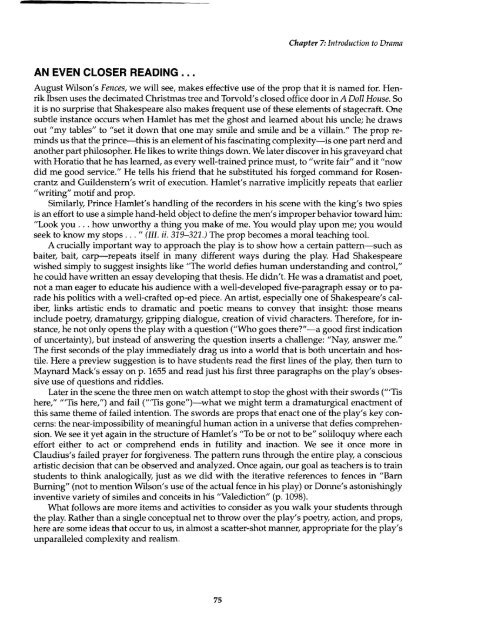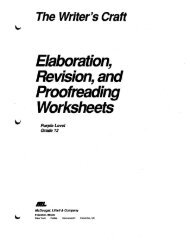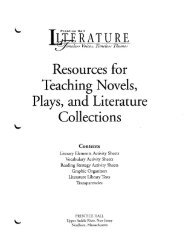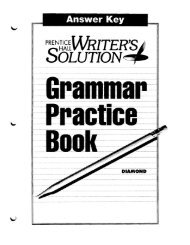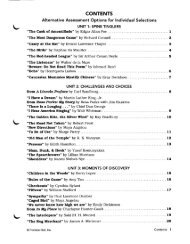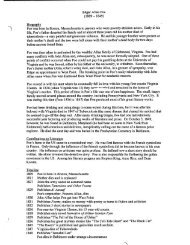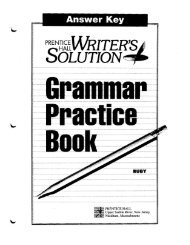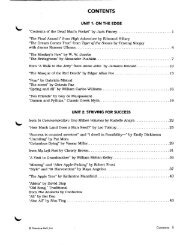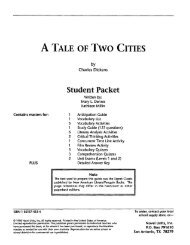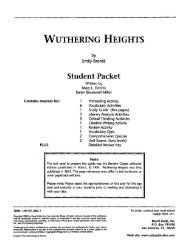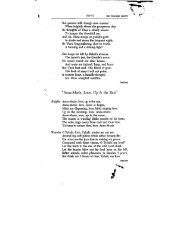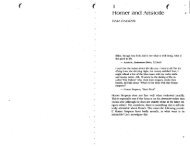English Literature & Composition - PopulationMe.com
English Literature & Composition - PopulationMe.com
English Literature & Composition - PopulationMe.com
Create successful ePaper yourself
Turn your PDF publications into a flip-book with our unique Google optimized e-Paper software.
Chapter 7: Introduction to Drama<br />
AN EVEN CLOSER READING ...<br />
August Wilson's Fences, we will see, makes effective use of the prop that it is named for. Henrik<br />
Ibsen uses the decimated Christmas tree and Torvold's closed office door in A Doll House. So<br />
it is no surprise that Shakespeare also makes frequent use of these elements of stagecraft. One<br />
subtle instance occurs when Hamlet has met the ghost and learned about his uncle; he draws<br />
out "my tables" to "set it down that one may smile and smile and be a villain." The prop reminds<br />
us that the prince-this is an element of his fascinating <strong>com</strong>plexity-is one part nerd and<br />
another part philosopher. He likes to write things down. We later discover in his graveyard chat<br />
with Horatio that he has learned, as every well-trained prince must, to "write fair" and it "now<br />
did me good service." He tells his friend that he substituted his forged <strong>com</strong>mand for Rosencrantz<br />
and Guildenstern's writ of execution. Hamlet's narrative implicitly repeats that earlier<br />
"writing" motif and prop.<br />
Similarly, Prince Hamlet's handling of the recorders in his scene with the king's two spies<br />
is an effort to use a simple hand-held object to define the men's improper behavior toward him:<br />
"Look you ... how unworthy a thing you make of me. You would play upon me; you would<br />
seek to know my stops ... " (III. ii. 319-321.) The prop be<strong>com</strong>es a moral teaching tool.<br />
A crucially important way to approach the play is to show how a certain pattern-such as<br />
baiter, bait, carp-repeats itself in many different ways during the play. Had Shakespeare<br />
wished simply to suggest insights like "The world defies human understanding and control,"<br />
he could have written an essay developing that thesis. He didn't. He was a dramatist and poet,<br />
not a man eager to educate his audience with a well-developed five-paragraph essay or to parade<br />
his politics with a well-crafted op-ed piece. An artist, especially one of Shakespeare's caliber,<br />
links artistic ends to dramatic and poetic means to convey that insight: those means<br />
include poetry, dramaturgy, gripping dialogue, creation of vivid characters. Therefore, for instance,<br />
he not only opens the play with a question ("Who goes there?"-a good first indication<br />
of uncertainty), but instead of answering the question inserts a challenge: "Nay, answer me."<br />
The first seconds of the play immediately drag us into a world that is both uncertain and hostile.<br />
Here a preview suggestion is to have students read the first lines of the play, then tum to<br />
Maynard Mack's essay on p. 1655 and read just his first three paragraphs on the play's obsessive<br />
use of questions and riddles.<br />
Later in the scene the three men on watch attempt to stop the ghost with their swords ('''Tis<br />
here," IIITis here,") and fail ("'Tis gone")-what we might term a dramaturgical enactment of<br />
this same theme of failed intention. The swords are props that enact one of the play's key concerns:<br />
the near-impossibility of meaningful human action in a universe that defies <strong>com</strong>prehension.<br />
We see it yet again in the structure of Hamlet's "To be or not to be" soliloquy where each<br />
effort either to act or <strong>com</strong>prehend ends in futility and inaction. We see it once more in<br />
Claudius's failed prayer for forgiveness. The pattern runs through the entire play, a conscious<br />
artistic decision that can be observed and analyzed. Once again, our goal as teachers is to train<br />
students to think analogically, just as we did with the iterative references to fences in "Bam<br />
Burning" (not to mention Wilson's use of the actual fence in his play) or Donne's astonishingly<br />
inventive variety of similes and conceits in his "Valediction" (p. 1098).<br />
What follows are more items and activities to consider as you walk your students through<br />
the play. Rather than a single conceptual net to throw over the play's poetry, action, and props,<br />
here are some ideas that occur to us, in almost a scatter-shot manner, appropriate for the play's<br />
unparalleled <strong>com</strong>plexity and realism.<br />
75


